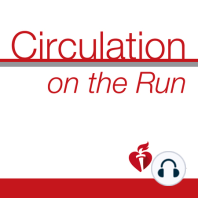20 min listen
Circulation September 10, 2019 Issue
ratings:
Length:
26 minutes
Released:
Sep 9, 2019
Format:
Podcast episode
Description
Dr. Carolyn Lam: Welcome to Circulation on the Run, your weekly podcast summary and backstage pass to the journal and its editors. We're your cohosts. I'm Dr. Carolyn Lam, Associate Editor from the National Heart Center, and Duke National University of Singapore. Dr. Greg Hundley: And I'm Greg Hundley, associate editor from the Poly Heart Center at VCU health in Richmond, Virginia. Dr. Carolyn Lam: Greg, I'm so excited about the feature paper this week. You know it deals with machine learning. It's such a hot topic now, and this one particularly deals with machine learning and the prediction of the likelihood of an acute myocardial infarction. So everyone's going to want to listen to it. Let's discuss a couple of papers and get to it, shall we? Dr. Greg Hundley: Absolutely Carolyn, would you like to go first? Dr. Carolyn Lam: I sure would. So my first pick is the first study to investigate the overall importance of translational regulatory networks in myocardial fibrosis. This is the study from doctors Rackham and Cook from Duke NUS Medical School here in Singapore. Dr. Carolyn Lam: What they did is they generated nucleotide resolution translatome data during transforming growth factor beta one, or TGF beta one-driven cellular transition of human cardiac fibroblasts to myofibroblasts. So this technique identified the dynamic changes of RNA transcription and translation at several time points during the fibrotic response, revealing transient and early responder genes. Dr. Carolyn Lam: Now, very remarkably about one third of all the changes in gene expression in activated fibroblasts was subject to translational regulation and dynamic variation in the ribosome occupancy, affected protein abundance independent of RNA levels. Ribosome occupancy in the hearts of patients with dilated cardiomyopathy suggest that the same post-transcriptional regulatory network, which was underlying cardiac fibrosis. Now key network hubs included RNA binding proteins such as PUM2 and QKI that worked in concert to regulate the translation of target transcripts in the human disease hearts. Dr. Carolyn Lam: Furthermore, the authors showed that silencing of both PUM2 and QKI inhibited the transition of fibroblasts towards profibrotic myofibroblast in response to TGF beta one. Dr. Greg Hundley: You know, Carolyn, this whole aspect of fibroblasts and how they turn on and turn off, become myofibroblasts, such a hot topic in heart failure. What are the clinical implications of this work? Dr. Carolyn Lam: Yes, I agree. Well, threefold. First, these authors identified previously unappreciated genes under translational control, which could be novel candidates for disease biology and therapeutic targets. Dr. Carolyn Lam: Number two, they found that critical fibrosis factors impacted cellular phenotypes at a protein level only, and hence these cannot be appreciated using single cell, or bulk RNA sequencing approaches. So that was significant. Finally, RNA binding proteins was shown to be central to the fibrotic response and represent unexplored gene expression regulators, and of course potential diagnostic or therapeutic targets. Dr. Greg Hundley: Very nice Carolyn. Well, my next paper is also from the world of basic science, and it comes from Dr. Joseph Hill. Have we ever heard of him? Well of course, he's our Editor in Chief. He's going to discuss, he and his team investigated Polycycstin-1. Well, what is Polycycstin-1? It's a trans membrane protein, originally identified in autosomal dominant polycystic kidney disease, where it regulates the calcium permeate cation channel polycystin-2. So autosomal dominant, polycystic kidney disease patients develop renal failure, hypertension, left ventricular hypertrophy, atrial fibrillation and other cardiovascular disorders. These individuals harbor PC1 loss of function mutations in their cardiomyocytes, but the functional consequences of this are relatively unknown. Dr. Greg Hundley: Now PC1 is ubiquitously expressed
Released:
Sep 9, 2019
Format:
Podcast episode
Titles in the series (100)
Circulation December 19/26, 2017 Issue: Circulation Weekly: Your Weekly Summary & Backstage Pass To The Journal by Circulation on the Run
